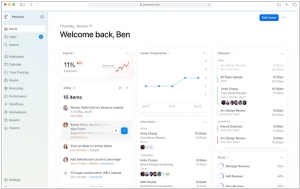Darktrace vs Lumu
March 10, 2025 | Author: Michael Stromann
25★
Darktrace AI interrupts in-progress cyber-attacks in seconds, including ransomware, email phishing, and threats to cloud environments and critical infrastructure.
1★
A Platform Built to Streamline SecOps. Real-time detection, analysis, and response to network threats.
See also:
Top 10 XDR software
Top 10 XDR software
Cybersecurity, much like intergalactic hitchhiking, is all about knowing what’s out there before it knows about you. Darktrace and Lumu both claim to do exactly that, using mysterious and slightly ominous things like AI, machine learning and real-time monitoring. They sit in your network, watching, analyzing and probably judging your taste in cat videos, all while integrating seamlessly (or so they claim) with other security tools. In short, they are the sort of systems that, if they were people, would stand in the corner of a party looking deeply suspicious and occasionally shouting, "That’s an anomaly!"
Darktrace, which hails from the United Kingdom and has been lurking in cyberspace since 2013, is a self-learning AI powerhouse that doesn’t just detect threats—it actively fights back. If your network were a spaceship, Darktrace would be the slightly neurotic autopilot that takes control the moment it senses danger, whether that’s an alien invasion or a rogue printer suddenly trying to contact a server in North Korea. It’s built for large enterprises, big budgets and people who enjoy reading about neural networks over breakfast.
Lumu, on the other hand, is the newer kid on the block, emerging from the United States in 2019 with a much simpler and frankly, lazier philosophy: don’t stop threats—just find out where they’ve already broken in. It’s designed for smaller businesses and those who like to know just how compromised they really are without spending a fortune. Instead of fighting back like an overenthusiastic AI warrior, Lumu quietly collects evidence of wrongdoing, hands you a report and says, "Well, this is awkward."
See also: Top 10 XDR software
Darktrace, which hails from the United Kingdom and has been lurking in cyberspace since 2013, is a self-learning AI powerhouse that doesn’t just detect threats—it actively fights back. If your network were a spaceship, Darktrace would be the slightly neurotic autopilot that takes control the moment it senses danger, whether that’s an alien invasion or a rogue printer suddenly trying to contact a server in North Korea. It’s built for large enterprises, big budgets and people who enjoy reading about neural networks over breakfast.
Lumu, on the other hand, is the newer kid on the block, emerging from the United States in 2019 with a much simpler and frankly, lazier philosophy: don’t stop threats—just find out where they’ve already broken in. It’s designed for smaller businesses and those who like to know just how compromised they really are without spending a fortune. Instead of fighting back like an overenthusiastic AI warrior, Lumu quietly collects evidence of wrongdoing, hands you a report and says, "Well, this is awkward."
See also: Top 10 XDR software





